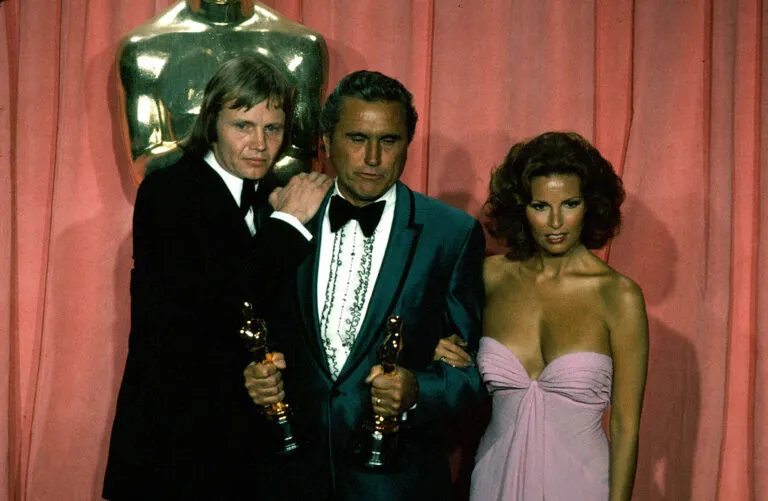Looking at old Oscar photos, particularly those from the 1970s, brings back a lot of memories. These images offer a glimpse into an era when the Academy Awards were more than simply an industry gathering; they were a spectacular spectacle that captivated millions of viewers around the globe.
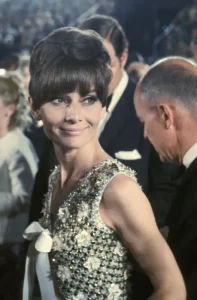
Their attendance at the Oscars added a particular allure that appears to have faded over time, as the stars of that era were practically legendary. This charm was a blend of elegance and mystery.
These images, especially those from the mid-1970s, depict a time when Hollywood seemed untouchable and everything was different, but its stars were well-known and contributed style and substance to the big screen.
One year that stands out is 1975. The glamor, political remarks, and controversies that surrounding the 47th Academy Awards have made it a noteworthy event even after several decades. In American history, the year was a turning point.

The Vietnam War was ending, social movements were transforming the nation, and Hollywood was increasingly caught between art and activity. As a result, rather than merely celebrating films, the 1975 Oscars reflected the cultural tensions of the day.
One of the main figures of the evening was Dustin Hoffman. Hoffman didn’t feel like celebrating being nominated for the Lenny Bruce role in the biographical film Lenny. Known for being a vocal critic of the Academy Awards’ glitz and splendor, Hoffman referred to the event as “ugly” and “grotesque,” comparing it to a pageant for beauty. His distaste for the evening was evident in the way he distanced himself from the glitz that surrounded him, despite the fact that his performance had earned him a nomination for Best Actor.
Hoffman’s critical attitude caused some awkward circumstances. Frank Sinatra, the show’s host, made fun of Hoffman’s attitude by joking that if he won, “he’s going to have a friend pick it up for him—George C. Scott.”

The reference was to Scott’s famous refusal to accept his Best Actor honor for Patton in 1971. However, the audience didn’t find Sinatra’s remark amusing, a sign that the Oscars’ humor was starting to clash with the times’ increasing gravity.
Sinatra’s mediocre on-stage performance added to the strain. Despite his reputation for charm, Sinatra struggled to execute his lines, appeared rather drunk, and made several awkward references to his Italian-American heritage.
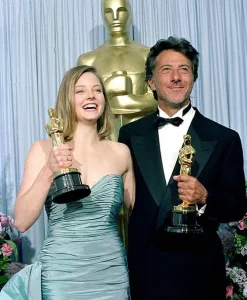
Reviewers also voiced their disdain of the crowd, including Roger Ebert of the Chicago Sun-Times, who noted that Sinatra was jeered at one point, which is almost unheard of for the popular artist.
The notion that the Oscars were less political in previous decades is often challenged by incidents such as the one that occurred during the 1975 event. Bert Schneider, the filmmaker of the Vietnam War documentary Hearts & Minds, walked the stage to accept the Best Documentary award. The Vietnam War, which had divided the country for years, came into sharp focus during his acceptance speech.

Schneider read aloud a telegram from Viet Cong Ambassador Dinh Ba Thi congratulating the American anti-war movement “for all they have done on behalf of peace”. This was a unique Oscars event, and not everyone in the audience was pleased with it. Bob Hope, a longtime supporter of the Vietnam War, was particularly angered by Schneider’s comments.
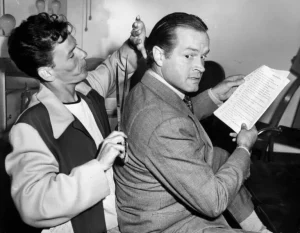
The Academy disapproved of the political sentiments made during the performance, according to Hope’s reaction, which was presented to the audience by Sinatra within an hour. Hope was publically reprimanded for this by Shirley MacLaine, one of the co-hosts of the event, who emphasized that she did not speak for the Academy as a whole.
Warren Beatty also contributed his voice with a scathing, “Thank you, Frank, you old Republican,” creating a clear separation between the more progressive voices in Hollywood and the elite of the industry.
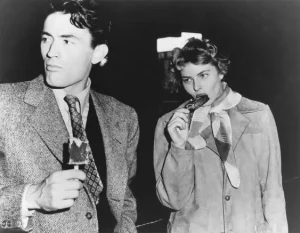
Amid the political tensions of the evening, Ingrid Bergman’s acceptance speech for Best Supporting Actress was one of the few moments of grace. Although Bergman had been rejected by Hollywood years earlier for her relationship with director Roberto Rossellini, she was receiving a standing ovation for her role in Murder on the Orient Express. At the age of 59, Bergman was a legendary figure, and many saw her win as a sort of atonement and a Hollywood moment of acknowledging its past wrongdoings.
In her acceptance speech, Bergman was modest and said that another nominee, Valentina Cortese, was more deserving of the award. Her remarks revealed her personal modesty as well as the general embarrassment Hollywood still felt for the way it had handled her during the height of her controversy in the late 1940s.

The most remembered image of the 1975 Oscars, however, might not be the winners or the political speeches, but rather the fairly ordinary photo of Jon Voight and Raquel Welch. As presenters that night, the two celebrities were responsible for announcing the Best Cinematography award.
Voight stood behind Welch, who looked gorgeous in a traditional black tuxedo and a deep pink gown. Together, they embodied the glamour of the time and were the pinnacle of Hollywood monarchy.

But in recent years, this image has gained controversy. Social media users have meticulously analyzed Voight’s stance, with some contending that, by today’s standards, his hold on Welch is outdated. One critic commented, “Jon looks like a creep,” while another inferred that Welch appeared uncomfortable.
A comparable proportion of respondents, however, defended the picture by pointing out that social mores had changed in the 1970s. “You have no opinion if you weren’t around then,” one person stated. The discrepancy in answers demonstrates how our cultural perspective has evolved over time, with modern sensibilities often clashing with traditional customs.
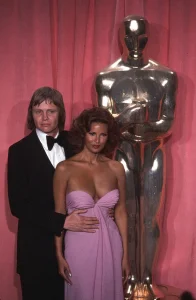
The 47th Academy Awards were a night of contrasts: splendor and shame, political announcements and personal triumphs. On that night, the iconic characters of vintage Hollywood shared the stage with the more outspoken, forward-thinking voices of the younger generation. The movies that were shown that night, like The Godfather Part II, were timeless, but the event itself captured a moment of change.
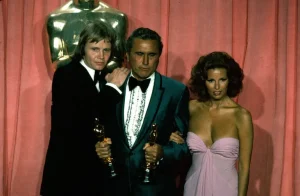
In addition to their beauty, the images from that night continue to influence us now because of what they reveal about Hollywood, politics, and society at the time. The 1975 Oscars are still seen as a window into a period that was halfway between the old and the new, when glamour and activism were beginning to collide on the world’s most glamorous stage.
